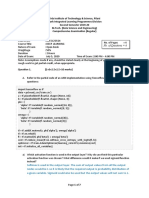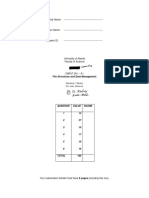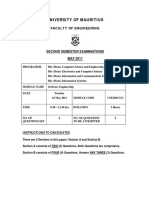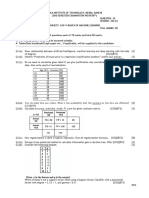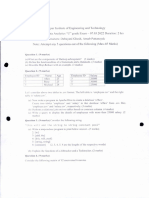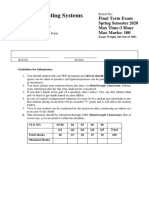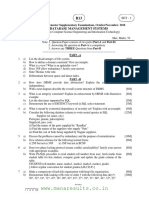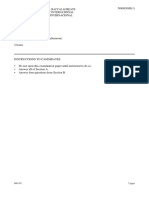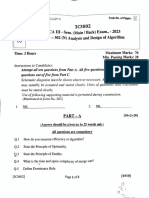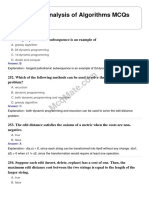Dsecl Zg519-Ec3r-1 PDF
Dsecl Zg519-Ec3r-1 PDF
Uploaded by
srirams007Copyright:
Available Formats
Dsecl Zg519-Ec3r-1 PDF
Dsecl Zg519-Ec3r-1 PDF
Uploaded by
srirams007Original Title
Copyright
Available Formats
Share this document
Did you find this document useful?
Is this content inappropriate?
Copyright:
Available Formats
Dsecl Zg519-Ec3r-1 PDF
Dsecl Zg519-Ec3r-1 PDF
Uploaded by
srirams007Copyright:
Available Formats
Birla Institute of Technology & Science, Pilani
Work-Integrated Learning Programmes Division
Second Semester 2019-2020
M.Tech (Data Science and Engineering)
End-Semester Test (EC-3 Regular)
Course No. : DSECF ZG519
Course Title : DATA STRUCTURE ALGORITHMS AND DESIGN
Nature of Exam : Closed Book
No. of Pages =3
Weightage : 40%
No. of Questions = 9
Duration : 150 Min
Date of Exam : 22-09-2019[AN]
Note:
1. Please follow all the Instructions to Candidates given on the cover page of the answer book.
2. All parts of a question should be answered consecutively. Each answer should start from a fresh page.
3. Assumptions made if any, should be stated clearly at the beginning of your answer.
Answer All the Questions (Only in the pages mentioned against questions. If you need more
pages. Continue remaining answers from page 16 onwards, we have provided extra space at
each question)
Question 1: [3M] [to be answered only in page 2]
Q.1. Show how to implement a queue using two stacks. Analyze the running time of the
queue operations.
Question 2: [2M] [to be answered only in page 3]
Q.2. How many instructions are executed when we multiply n × m matrix A with m × r
matrix B?
Question 3: [2+3 =5M] [to be answered only in pages 4-5]
Q.3. Question based on fig-1,Based on AVL-Tree in the fig: 1 below:
(a) Draw the resulting tree after 5 is removed, but before any rebalancing takes
place. Label each node in the resulting tree with its balance factor.
(b) Rebalance the tree that results from (a). Draw a new tree for each rotation
that occurs when rebalancing the AVL Tree.
Fig-1
DSECL ZG519 (EC-3 Regular) Second Semester 2019-2020 Page 1 of 3
Question 4: [5M] [to be answered only in pages 6-7]
Q.4. Question based on fig:2, For the given Graph G. Using Floyd-Warshall algorithm
compute the shortest-path weights matrix D(k).
Fig-2
Question 5: [5M] [to be answered only in pages 8-9]
Q.5. Question based on fig:3, For the given graph G, find the shortest path from the node A
to all other nodes.
Fig-3
Question 6: [3+3 =6M] [to be answered only in pages 10-11]
Q.6. Suppose we’re using quick sort to process data that we’re receiving from a connection
in a networked system. We want to cover our system from the possibility of being
“sabotaged” by hostile connections — we could receive data that is specifically crafted
to cause quick sort to have its worst- case performance and thus make our system
consume excessive resources and time (rendering it unable to efficiently respond to
other connections).
(a) Assuming that quick sort simply chooses the first element as the pivot (instead of the
median of first, last, and middle), what is the arrangement of data that produces the
worst-case performance in quick sort? (that is, if you were the attacker trying to sabotage
the system, what data would you have to send?)
(b) Suggest a simple strategy (hopefully requiring no more than linear time) to avoid the
problem. That is, a strategy to guarantee that quick sort will run in O(n log n) most of
the time, regardless of input data, even if this input data is maliciously created. Notice
that in the context of this question, you’re not allowed to change the way quick sort
selects the pivot (in fact, you will hopefully suggest a strategy that works regardless of
how quick sort selects the pivot).
DSECL ZG519 (EC-3 Regular) Second Semester 2019-2020 Page 2 of 3
Question 7: [5M] [to be answered only in pages 12]
Q.7. Question based on fig-4, List the nodes of the tree below in preorder,
postorder, and breadth-first order.
Fig-4.
Question 8: [5M] [to be answered only in pages 13-14]
Q.8. There are four pages. Page A contains a link to page B, a link to page C, and a link to
page D. Page B contains one single link to page D. Page C points to pages A and D, and
page D points to pages A and C. Using page rank algorithm find the page rank. [ Hint:
the page are initial ranked 1, use the standard damping factor, find page rank till 5
iteration]
Question 9: [4M] [to be answered only in pages 14-15]
Q.9. Construct K-D tree for the following data (3,6), (17,15), (13,15), (6,12), (9,1), (2,7),
(10,19).
*** ALL THE BEST ***
DSECL ZG519 (EC-3 Regular) Second Semester 2019-2020 Page 3 of 3
You might also like
- Hackerrank TestDocument3 pagesHackerrank Testswapnil0% (7)
- Solution Dseclzg524 05-07-2020 Ec3rDocument7 pagesSolution Dseclzg524 05-07-2020 Ec3rsrirams007No ratings yet
- DVI Assignment - Construction AnalysisDocument3 pagesDVI Assignment - Construction Analysissrirams007No ratings yet
- Big O Notation Cheat Sheet: Time Complexity Classes ExplainedDocument1 pageBig O Notation Cheat Sheet: Time Complexity Classes ExplainedEmam HasanNo ratings yet
- Data Interpretation Guide For All Competitive and Admission ExamsFrom EverandData Interpretation Guide For All Competitive and Admission ExamsRating: 2.5 out of 5 stars2.5/5 (6)
- Regents Exams and Answers Geometry Revised EditionFrom EverandRegents Exams and Answers Geometry Revised EditionNo ratings yet
- Solution Dseclzg524!01!102020 Ec2rDocument6 pagesSolution Dseclzg524!01!102020 Ec2rsrirams007100% (1)
- DSE 2020-21 2nd Sem DL Problem Solving 2.0Document9 pagesDSE 2020-21 2nd Sem DL Problem Solving 2.0srirams007No ratings yet
- Assignment PDFDocument2 pagesAssignment PDFMoazzam HussainNo ratings yet
- Dsecl Zg519-Ec3m PDFDocument3 pagesDsecl Zg519-Ec3m PDFsrirams007No ratings yet
- DSAD Makeup Question PDFDocument3 pagesDSAD Makeup Question PDFJitamitra BehuraNo ratings yet
- DBSA AK-Regular Mid-Sem Question PapersDocument3 pagesDBSA AK-Regular Mid-Sem Question Paperspvaid2208No ratings yet
- Introduction To Computing and Information Technology 2 Final ExaminationDocument7 pagesIntroduction To Computing and Information Technology 2 Final ExaminationKhalidNo ratings yet
- Mel Zg641 Ec-3r First Sem 2022-2023Document2 pagesMel Zg641 Ec-3r First Sem 2022-20232022ht80553No ratings yet
- Math2Z03 Earn Test1 Fall2023 EmptyTestDocument10 pagesMath2Z03 Earn Test1 Fall2023 EmptyTestHashir ImamNo ratings yet
- Csizg518 Nov25 AnDocument2 pagesCsizg518 Nov25 AnTabithaDsouza100% (1)
- Waep 2016 Yr12 Apps u34 s1Document12 pagesWaep 2016 Yr12 Apps u34 s1Varad VaidyaNo ratings yet
- 2023 SuppDocument10 pages2023 Suppdlamini16No ratings yet
- Sample FinalDocument8 pagesSample Finalshravanmadhu45No ratings yet
- 2022 06 01 ExamDocument5 pages2022 06 01 Examktang950No ratings yet
- Data Mining Comprehensive Exam - Regular PDFDocument3 pagesData Mining Comprehensive Exam - Regular PDFsrirams007No ratings yet
- 4.de ZG526 Ec-3r First Sem 2022-2023Document2 pages4.de ZG526 Ec-3r First Sem 2022-2023aaquibkhanNo ratings yet
- 2r Second SemDocument2 pages2r Second SemChinna DuraiNo ratings yet
- Csizg525 Nov29 FNDocument2 pagesCsizg525 Nov29 FNjoseNo ratings yet
- 2023-24 First Sem - Computer Vision Compre MakeupDocument4 pages2023-24 First Sem - Computer Vision Compre Makeup2022ac05322No ratings yet
- Exam 2012T1Document34 pagesExam 2012T1nijohe7219No ratings yet
- Cse2001y 5 2011 2 PDFDocument8 pagesCse2001y 5 2011 2 PDFmy pcNo ratings yet
- Cse2001y 5 2011 2 PDFDocument8 pagesCse2001y 5 2011 2 PDFmy pcNo ratings yet
- EGM272MEE321 Final Exam 2022Document3 pagesEGM272MEE321 Final Exam 2022muyembechibwe101No ratings yet
- Final Exam Summer A 19 CompleteDocument9 pagesFinal Exam Summer A 19 Completeapi-335458084No ratings yet
- Faculty of Environment and TechnologyDocument8 pagesFaculty of Environment and TechnologyLibraryNo ratings yet
- 23mst124tma02 BDocument7 pages23mst124tma02 BThomas RaffaëllyNo ratings yet
- Exam 19 March QuestionsDocument13 pagesExam 19 March Questionsgemchis dawoNo ratings yet
- Hardware Software Codesign Question PaperDocument2 pagesHardware Software Codesign Question PaperRaviNo ratings yet
- Bits ZG553 Ec-2r First Sem 2019-2020Document2 pagesBits ZG553 Ec-2r First Sem 2019-2020vithyaNo ratings yet
- Ama 2115 Mathematics for Science Computational MathsDocument3 pagesAma 2115 Mathematics for Science Computational Mathsc36002185No ratings yet
- 0580 s08 QP 2Document25 pages0580 s08 QP 2Elissar129No ratings yet
- Sample Mid Term ACIDocument3 pagesSample Mid Term ACIshipra.luckyNo ratings yet
- Semester 1 Examinations 2018/2019: Programme (S)Document7 pagesSemester 1 Examinations 2018/2019: Programme (S)fuckoffmanNo ratings yet
- 0580 s08 QP 2 2Document25 pages0580 s08 QP 2 2Elissar129No ratings yet
- 3SFE618 Formal Methods 2009Document18 pages3SFE618 Formal Methods 2009Hasini PereraNo ratings yet
- Tm112 Final by ISA 1st EditionDocument20 pagesTm112 Final by ISA 1st EditionnawafzxsuNo ratings yet
- BML End SemDocument2 pagesBML End SemRoushan VermaNo ratings yet
- Exam 04Document29 pagesExam 04George MSenoirNo ratings yet
- Analysis and Design of AlgorithmsDocument2 pagesAnalysis and Design of Algorithmscapota3822No ratings yet
- Dsebl ZG522Document4 pagesDsebl ZG522Raju DNANo ratings yet
- b.sc ( Computer Science ) 2019 Patternqp3Document114 pagesb.sc ( Computer Science ) 2019 Patternqp3shravanisagarbhosaleNo ratings yet
- Introduction To Computing and Information Technology 2 Final ExaminationDocument6 pagesIntroduction To Computing and Information Technology 2 Final ExaminationKhalidNo ratings yet
- CSE209 Document2Document4 pagesCSE209 Document2saluesNo ratings yet
- SVKM'S Nmims Mukesh Patel School of Technology Management& Engineering (Campus Name)Document16 pagesSVKM'S Nmims Mukesh Patel School of Technology Management& Engineering (Campus Name)Sexyy BoyyNo ratings yet
- UEC718Document2 pagesUEC718Abhi MittalNo ratings yet
- Solid State Devices QuestionDocument3 pagesSolid State Devices QuestionSharif Shah NewazNo ratings yet
- LP Maths Grade 8 June 2024 QP and MemoDocument14 pagesLP Maths Grade 8 June 2024 QP and Memoalwandebuthelezi59No ratings yet
- ECD3702 Portfolio May-June Examination 2023 - 230517 - 083213Document4 pagesECD3702 Portfolio May-June Examination 2023 - 230517 - 083213Kuda ChiwandireNo ratings yet
- 4.de ZG526 Ec-2r First Sem 2022-2023Document1 page4.de ZG526 Ec-2r First Sem 2022-2023aaquibkhanNo ratings yet
- Trials F M2011 S2Document15 pagesTrials F M2011 S2Nolan AshNo ratings yet
- Trials-F-M2011-S2 2Document15 pagesTrials-F-M2011-S2 2Nolan AshNo ratings yet
- TM254 - Final - Fall2022-2023Document6 pagesTM254 - Final - Fall2022-2023Omar Tawfok100% (1)
- Final Paper SolutionDocument5 pagesFinal Paper Solutionamna shahbazNo ratings yet
- Cad CamDocument7 pagesCad CamandhracollegesNo ratings yet
- Dbms Paper 2018Document1 pageDbms Paper 2018Vivek ParmarNo ratings yet
- Computer Science Paper 1 HLDocument7 pagesComputer Science Paper 1 HLSridhar RamalingamNo ratings yet
- Class9 - Maths - UT1 - Jun2021 NewDocument3 pagesClass9 - Maths - UT1 - Jun2021 NewArhaan JavedNo ratings yet
- Ada 2023Document3 pagesAda 2023Chaitanya JagarwalNo ratings yet
- Computer Studies - Computer Studies Form 2 - Zeraki Achievers 5.0 - Marking SchemeDocument9 pagesComputer Studies - Computer Studies Form 2 - Zeraki Achievers 5.0 - Marking SchemekipepeosafespaceNo ratings yet
- SLA - Class Test - 5 - AnswerKeyDocument2 pagesSLA - Class Test - 5 - AnswerKeycadi0761No ratings yet
- Applied RVE Reconstruction and Homogenization of Heterogeneous MaterialsFrom EverandApplied RVE Reconstruction and Homogenization of Heterogeneous MaterialsNo ratings yet
- ClouderaDesignDocument - v0.9.6 With Comments Sjors DignumDocument42 pagesClouderaDesignDocument - v0.9.6 With Comments Sjors Dignumsrirams007No ratings yet
- Chemical ElementsDocument1 pageChemical Elementssrirams007No ratings yet
- Explain The Issues in Designing Distributed SystemsDocument6 pagesExplain The Issues in Designing Distributed Systemssrirams007No ratings yet
- SPA Full Course PPTs (9 Files Merged)Document239 pagesSPA Full Course PPTs (9 Files Merged)srirams007No ratings yet
- Lecture-4-HCL-DSE - Sumita NarangDocument31 pagesLecture-4-HCL-DSE - Sumita Narangsrirams007No ratings yet
- Dapr For NET DevelopersDocument129 pagesDapr For NET Developerssrirams007No ratings yet
- NLP2 7Document400 pagesNLP2 7srirams007No ratings yet
- Midsem Regular QPDocument2 pagesMidsem Regular QPsrirams007No ratings yet
- Lecture-1to8-HCL-DSE - Sumita Narang - IDS PDFDocument304 pagesLecture-1to8-HCL-DSE - Sumita Narang - IDS PDFsrirams007No ratings yet
- Database Design For Dynamic Online Surveys: Conference PaperDocument9 pagesDatabase Design For Dynamic Online Surveys: Conference Papersrirams007No ratings yet
- Lecture-7-HCL-DSE - Sumita NarangDocument65 pagesLecture-7-HCL-DSE - Sumita Narangsrirams007No ratings yet
- Lecture-1-HCL-DSE - Sumita NarangDocument42 pagesLecture-1-HCL-DSE - Sumita Narangsrirams007No ratings yet
- Introduction To Data ScienceDocument363 pagesIntroduction To Data Sciencesrirams007100% (2)
- Lecture-8-HCL-DSE - Sumita NarangDocument37 pagesLecture-8-HCL-DSE - Sumita Narangsrirams007No ratings yet
- Architecting Cloud Native NET Apps For AzureDocument195 pagesArchitecting Cloud Native NET Apps For Azuresrirams007100% (2)
- SECTION 1 - DSE - Session 1 - 29th August 2020Document79 pagesSECTION 1 - DSE - Session 1 - 29th August 2020srirams007No ratings yet
- IDS - 3 - Data Analytics - Part-2 - Methodologies - DantuDocument60 pagesIDS - 3 - Data Analytics - Part-2 - Methodologies - Dantusrirams007No ratings yet
- 3) S2 - 19 - ISM - SECTION A - Session 3 - 12th Sept 2020Document65 pages3) S2 - 19 - ISM - SECTION A - Session 3 - 12th Sept 2020srirams007No ratings yet
- Lecture-6-HCL-DSE-Sumita NarangDocument25 pagesLecture-6-HCL-DSE-Sumita Narangsrirams007No ratings yet
- Lecture-5-HCL-DSE - Sumita Narang-2Document40 pagesLecture-5-HCL-DSE - Sumita Narang-2srirams007No ratings yet
- 4) S2 - 19 - ISM - SECTION A - Session 4 - 19th Sept 2020Document43 pages4) S2 - 19 - ISM - SECTION A - Session 4 - 19th Sept 2020srirams007No ratings yet
- 4) S2-19-ISM-SECTION A - Session 4-19th Sept 2020-ModifiedDocument40 pages4) S2-19-ISM-SECTION A - Session 4-19th Sept 2020-Modifiedsrirams007No ratings yet
- Data Mining Comprehensive Exam - Regular PDFDocument3 pagesData Mining Comprehensive Exam - Regular PDFsrirams007No ratings yet
- Computer Organization and Architecture 10th Edition Stallings Test Bank PDFDocument7 pagesComputer Organization and Architecture 10th Edition Stallings Test Bank PDFsrirams007No ratings yet
- Data Structures and Algorithms Design (Regular) DSE PDFDocument9 pagesData Structures and Algorithms Design (Regular) DSE PDFsrirams007No ratings yet
- Ass 2 QDocument6 pagesAss 2 QUmer CheemaNo ratings yet
- Cit310 Summary From NoungeeksDocument43 pagesCit310 Summary From NoungeeksayomideolundegunNo ratings yet
- Design and Analysis of Algorithms PDFDocument15 pagesDesign and Analysis of Algorithms PDFRoop DubeyNo ratings yet
- Unit 4 PDFDocument105 pagesUnit 4 PDFAkhil YadavNo ratings yet
- Linked ListDocument97 pagesLinked ListIsha TripathiNo ratings yet
- Gate Level Algo DesignDocument20 pagesGate Level Algo DesignKanwal PreetNo ratings yet
- Vidya Mam PPT - Lecture1Document22 pagesVidya Mam PPT - Lecture1koushik RamNo ratings yet
- AI1Document77 pagesAI1khshri3No ratings yet
- Advanced Algorithm Design and Analysis (1x1)Document96 pagesAdvanced Algorithm Design and Analysis (1x1)Abraham AlemsegedNo ratings yet
- cs170 sp95 mt1 Sol PDFDocument6 pagescs170 sp95 mt1 Sol PDFJaspreetSinghNo ratings yet
- Mid Semester: ExaminationDocument5 pagesMid Semester: ExaminationLekha PylaNo ratings yet
- Solve Shortest Path Problem in Graph - MATLAB Graphshortestpath - MathWorks India PDFDocument5 pagesSolve Shortest Path Problem in Graph - MATLAB Graphshortestpath - MathWorks India PDFMohd Nasim100% (1)
- Spa Sem 2 PDFDocument754 pagesSpa Sem 2 PDFAayushi PatelNo ratings yet
- Design and Analysis of Algorithms Solved MCQs (Set-11)Document7 pagesDesign and Analysis of Algorithms Solved MCQs (Set-11)Aamir ShaheenNo ratings yet
- Chapter 2 - DS BasicsDocument34 pagesChapter 2 - DS BasicsHedmondNo ratings yet
- Sham Daa MCQDocument2 pagesSham Daa MCQsanjana jadhavNo ratings yet
- CSC 207Document59 pagesCSC 207adandongolambertdanielNo ratings yet
- Theory of ComputationDocument37 pagesTheory of ComputationMadhu BalaNo ratings yet
- 8335 Decap770 Advanced Data StructuresDocument241 pages8335 Decap770 Advanced Data StructuresShukla ji.No ratings yet
- Longest Increasing SubsequenceDocument3 pagesLongest Increasing SubsequenceModernZenNo ratings yet
- 2017 Design and Analysis of Algorithms NCS 501Document2 pages2017 Design and Analysis of Algorithms NCS 501Kishan KushvahaNo ratings yet
- Daa ProblemsDocument17 pagesDaa ProblemsPavan ShanbhagNo ratings yet
- CSE 326: Data Structures Lecture #2 Analysis of Algorithms: Alon Halevy Fall Quarter 2000Document21 pagesCSE 326: Data Structures Lecture #2 Analysis of Algorithms: Alon Halevy Fall Quarter 2000Er Umesh ThoriyaNo ratings yet
- Spring 2021 - CS701 - 4 - SOLDocument2 pagesSpring 2021 - CS701 - 4 - SOLMuzammal SadiqNo ratings yet
- Viva Questions For DAA UoPDocument10 pagesViva Questions For DAA UoPSuparnaNo ratings yet
- 02 Greedy Algorithms ProblemsDocument18 pages02 Greedy Algorithms ProblemsamarjeetNo ratings yet
- Mod1 DsDocument48 pagesMod1 DsTibin ThomasNo ratings yet

